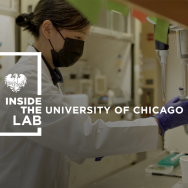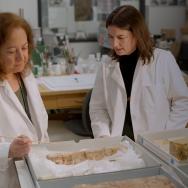Editor’s Note: This is part of a new series called Inside the Lab, which gives audiences a first-hand look at the research laboratories at the University of Chicago and the scholars who are tackling some of the world’s most complex problems.
Discover More From This Series
In a sunlit greenhouse atop a biology building on the campus of the University of Chicago, members of Prof. Chuan He’s laboratory are working to modify plants so that they can yield substantially more food, even under the stress of drought.
As climate change continues, experts say extreme weather and drought will become more common—so adaptations could be critical to produce enough food to feed the world and materials to keep society running.
Years ago, He’s lab made a surprising discovery about the fundamental nature of genetics and RNA. Today, they’re using this breakthrough to develop new ways to encourage plant growth.
To take a deeper dive into the research, we spoke with Chuan He, who is the John T. Wilson Distinguished Service Professor of Chemistry, Biochemistry and Molecular Biology; and Guanqun Wang and Haoxuan Li, postdoctoral researchers working in the He laboratory.
What makes a plant grow bigger or smaller?
He: Plants have complicated systems to survive in different environment. When you and I see trouble, we can run away. But plants, unfortunately, have to stay where they are. So they have ways to sense the surrounding environmental conditions and adapt to them. For example, if there is not enough water, the plant may pause growth so that it needs less water.
Essentially, we found a way to modulate this regulation. We could encourage plant to grow under most conditions.
How did you first get the idea to modify plants in this way?
He: In the early 2000s, we had been wondering if there was a key piece missing from our understanding of gene expression.
We have tens of trillions of cells in our bodies. They all come from early embryos. Some become eyes, and others become kidneys, and bones etc. Yet the sequence of DNA in most cells in your body is the same. How do those cells become so different?
Well, DNA is the complete set of instructions, but those instructions are carried out by RNA. We are increasingly realizing that RNA is not just a messenger—it plays lots of regulatory roles itself. My lab discovered certain proteins that modify the RNA, which act to turn certain genes “on” and “off.” This process is reversible, so the organism can change and adapt to the environment.
In 2020, we discovered that we could use this knowledge and insert a protein into plants that affects the RNA expression in a way to make the plants grow bigger, faster, and yield more.
How much more?
He: In our tests we have been able to yield up to 50% more. For example, a rice plant will produce 30-50% more rice in the field.
Which plants have you tried so far?
Li: So far, we have tried rice, potatoes and tomatoes—all of which have responded to this treatment. We’re expanding our plant list; we would also like to do soybeans and maize.
What do the modified plants look like?
Wang: These plants look like normal plants, but they have much longer roots—about double. Longer roots mean they are more robust to drought. You can also see that their leaves are greener than unmodified plants. That is because they have more chlorophyll—their rates of photosynthesis are higher.
He: They also grow faster. In many places, if you can harvest a week earlier to avoid a winter storm, that can make a huge difference.
What’s the process?
He: Essentially, we start with a piece of DNA from green algae. We transfer that gene into the DNA of whichever plant we are modifying. As the plant grows, this new gene produces a protein called FTO, which changes the way the plant interprets its genome, and causes it to grow bigger and faster.
What do you see this discovery being used for?
He: There are two major implications to me.
The first is, of course, food security—enough food to sustain the population on Earth. We all face the same problem of climate change. The temperatures are rising, but importantly, the precipitation patterns are also changing.
In the places where you grow corn, or raise cattle on grass, some of those places won’t have enough rain to sustain that anymore. That will eventually reshape our agriculture. And it calls for crops that are more resistant to drought and stress.
But also, we’re talking about other materials we need. Lots of those things come from plants. Paper comes from plants, as do biofuels. Imagine if we can increase the yield of those things.
What would you say to someone who is nervous about GMO plants?
He: Well, with our method, it’s a little different from what most people think of with genetic engineering.
We’re not really changing the genome itself. What we change is the modifications the plant makes to RNA. We add a protein which changes the way the existing genome is interpreted by the plant.
Right now, that particular protein is taken from green algae and put into plants, but we are working to find a way that avoids using a foreign protein. In that case, you would only be using the plant’s own mechanisms.
What kind of equipment do you use in your lab? What does the process look like?
Wang: In the greenhouse, we measure how fast the modified plants are growing and other things, like their photosynthetic rates. Then we will take clippings of the plants and do single-cell sequencing of the rice or roots of the plants—meaning we map out how the DNA or RNA was expressed in a particular cell—in order to try to understand exactly what happened in the plants as a result of the modification. We’ll also run experiments; maybe we reduce the amount of water or fertilizer in the environment and see how the plants respond.
What role do students play in your research?
He: They are the key drivers in the lab, not only executing experiments but also proposing new ideas. We are partners.
What are the challenges you’re working on right now?
Wang: A major goal is to understand the specific molecular mechanisms behind these changes. Right now, we know that the plants grow better, but we cannot specifically say why.
Li: Some of the challenges we face are technological. For example, we would love to be able to watch the plants’ stem cells divide, like you can do with animal studies. But plants have thick cell walls that are harder to see through, so we can’t use the same technology that is used with mammalian cells.
In general, there is much less research on plants—we know a lot less about them than we do about animals—so there is a lot of new ground to cover.
Read more:
- RNA breakthrough creates crops that can grow 50% more potatoes, rice
- Big Brains podcast: How a Genetic Breakthrough Could Address Global Hunger, with Chuan He
- UChicago scientists uncover clues to mysterious but crucial genetic process
- RNA’s “joints” play key role in our gene expression, UChicago scientists find

